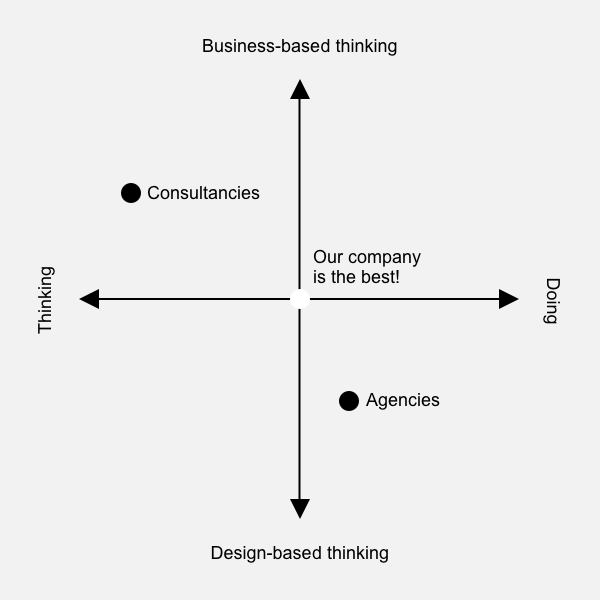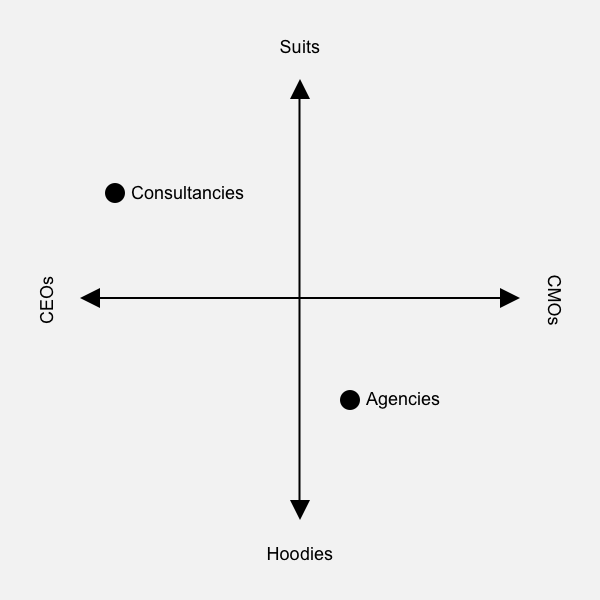
On the false opposition between design and business, and why design doing and strategic thinking cannot be separated.
In the last few years consulting companies (such as Deloitte, PwC, McKinsey, Accenture and others) started to invest heavily in design and creative competences, mostly by buying independent digital agencies or design studios. It is still to be seen how this merging of cultures and teams will work and if consulting companies can compete with agencies and break even with this business. But why they are doing it? Isn’t business consulting more money by the hour than design or advertising?
The reason, I think, is that consulting companies realised that they had no real impact on customer experience. In the end it is owned by the agencies who are making campaigns, working on the social media, designing and developing digital products for their clients, and so on. And this is very important place in the new digital world of experience economy, where everyone wants to be.
Of course, to counterattack, digital agencies are offering more consulting services in the areas where they have a lot of experience: digital product design and innovation, digital marketing, technology, digital transformation, startups as a service, etc.
The third player in the game are software houses (at least in Poland, where I work and live) who are starting to invest more and more in design services.
I’ve seen many presentations by companies like the above and in most of them there is some version of this chart (it’s also in this article at Adweek):
Of course every company have their own version of it with their logo at the center, because, hey, they are the best of all, and competitors are placed to the left or right, up and down.
Consultancies use it to show that they are better than design agencies, because they acquired some agencies and can now execute too. And agencies don’t know shit about business, and can only do stuff without thinking.
Agencies use it to show that they are better than consultancies, who are only making slides full of bullshit, and have no practical experience in making anything of value.
In reality it is probably more like this:
Consultancies have more traditional cultures (and dress codes) and better access to higher management, while agencies or software houses have more creative environments and are mostly working with CMOs or CIOs.
I suspect that this chart originated in consulting (they are the kings of charts like that) and agencies adapted it in defence, but I can tell you that the person who created it don’t know much about design.
Good Design is Good Business
First: what is business-based thinking? Thinking about profit? Most commercial designers are working to improve business, this is always the first thing on their minds. What is the value proposition, how to differentiate, make customers happy, make conversion better, sell more, make business processes more efficient, etc. The opposition of business and design is not true. Design is a tool for better business.
Consultancies will be better to change their thinking of designers as only producers or just people making things pretty or slightly more usable. Sure, there are designers who are more concerned with the visual side of things, and there are strategic designers doing more problem solving, but all of them are working to make better business.
Just check this article by Geoff Teehan about his UX Fund. In short: they invested in 10 companies focusing on great user experience and the ROI was amazing. Largely, because of the work of designers, we can presume.
According to Adobe’s Digital Trends 2018 report organizations that consider themselves design-driven are 69% more likely than their peers to have exceeded their 2017 business goals by a significant margin (22% vs. 13%). Organizations that value creativity also were 46% more likely to have exceeded their 2017 business goals by a noteworthy margin (19% vs. 13%).
Design is Thinking by Doing
Second: the opposition of thinking and doing sounds like bullshit to every seasoned designer. That’s why so many experienced designers have problems with the label “Design Thinking”.
The funny thing about design is that it is thinking by doing. You can’t separate one from the other. When you are designing new service or digital product, you are starting with sketches, then move to more high-fidelity designs, and make a lot of versions, and with every iteration there are more ideas, more questions, and more problems to solve.
I’m not surprised this is hard to get for traditional consultants: you need to work on little details and the big picture at the same time. It will emerge.
The work on design — how customers will experience your product in the end — often helps in clarifying the strategy. It is an important part of it.
At the beginning of a new project you often don’t know what your doing. But you’re not starting by merely thinking, but by doing it anyway. The more high-fidelity design work you have, the more you can learn from it. It can be a start, but you can’t learn much from the bunch of post-its or slides. This “learning by doing” is why methodologies like Agile, Lean UX, or Lean Startup exist.
So to conclude: please stop this false and simplistic view of the business vs. design, thinking vs. doing. It doesn’t make any sense. And today good design should be strategic investment for almost every business.
This article was originally published at The Startup on Medium.


No comments.